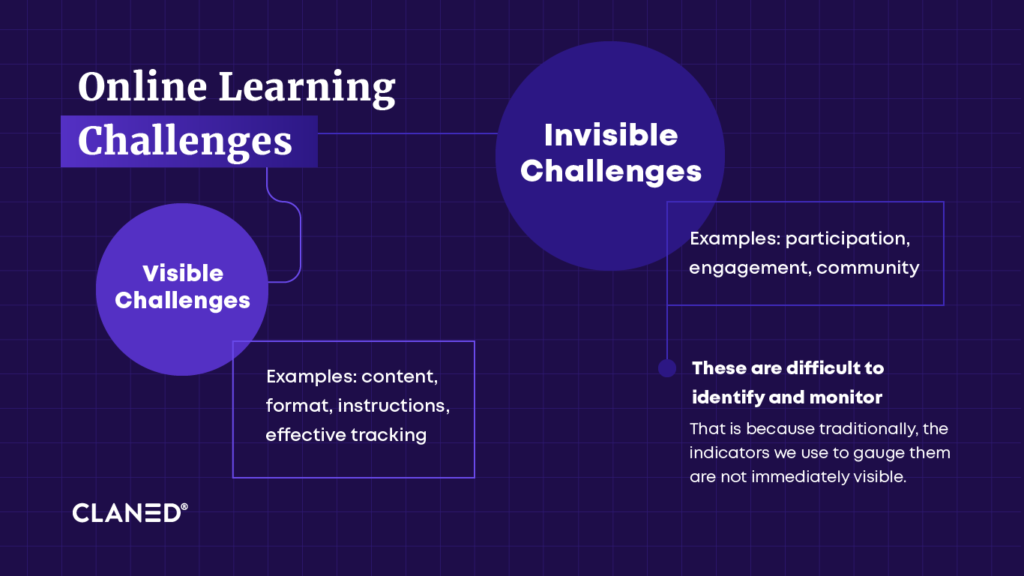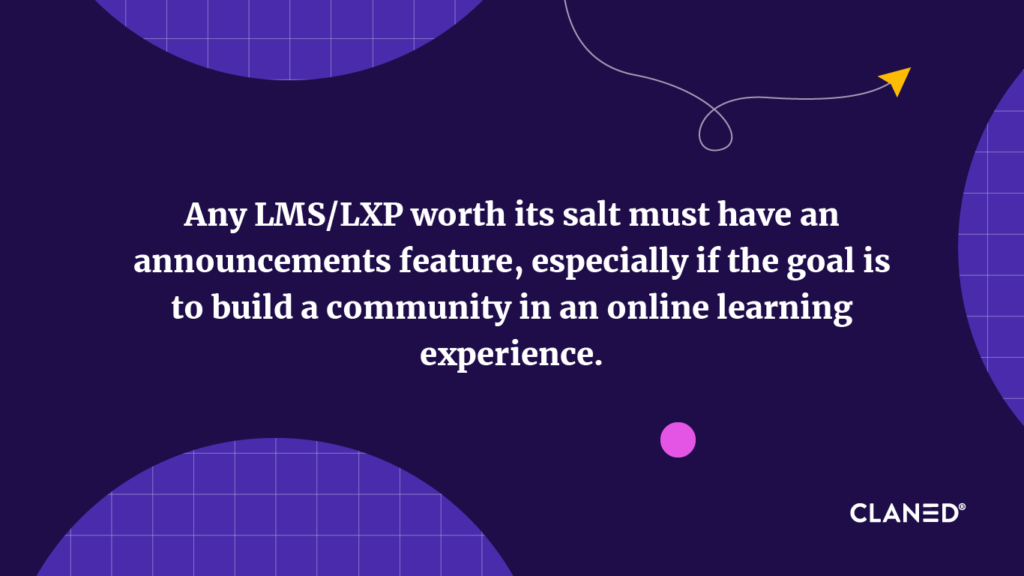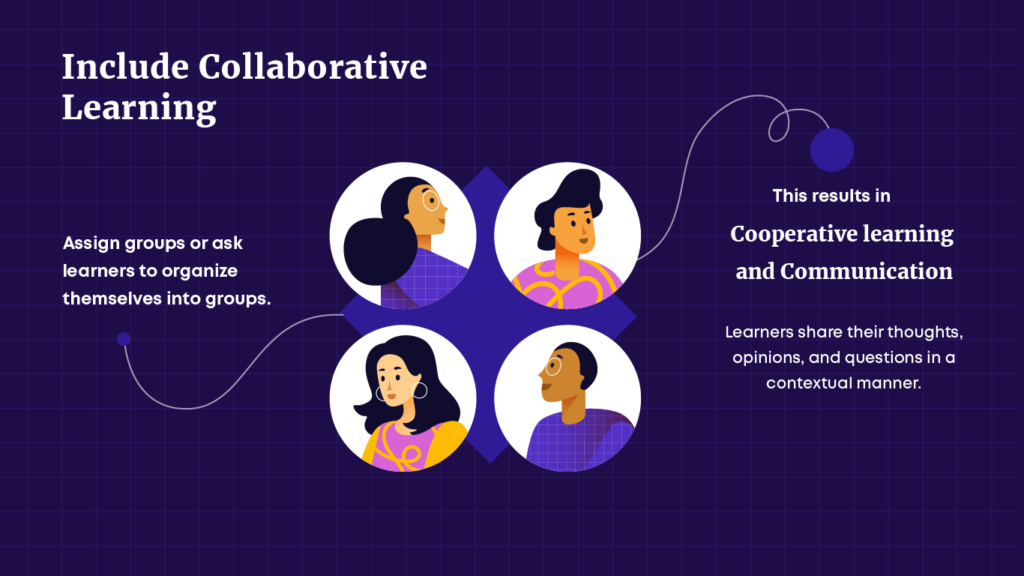Where’s the joy in learning without a sense of community? And while community-building might seem easier to achieve in traditional, face-to-face learning environments, it can just as easily be achieved in online learning environments. In fact, some feel that communities in online learning settings have the potential to be even stronger and more engaging.
Here’s a breakdown of the practices you can follow to create your own online learning community.
Community: The ‘Invisible’ Element in Online Learning
Online learning can be incredibly convenient. But occasionally, it can pose a few challenges for which trainers, and course creators require efficient solutions. After all, a successful learning experience must be a smooth learning experience.
Many of these challenges tend to center around more ‘visible’ elements of online learning. These elements – like content, format, instructions, and effective tracking – inevitably end up taking a more primary role when designing learning experiences.
Read: How to Make Videos for Online Courses

But it’s just as important to pay attention to the more ‘invisible’ elements of the learning experience. And although we use the term ‘invisible’, the truth is that in a traditional classroom or training setting, these elements are plain-as-day for trainers to see. These are the elements that lie at the heart of every learning experience – things like participation, engagement, and of course, community.
When we bring these elements to an online learning experience, it can often be difficult to identify and monitor them. That is because traditionally, the indicators and information we use to gauge them are not immediately visible.
Design Considerations: How to Build an Online Learning Community
But here’s the good news: despite these challenges, we can still use a number of strategies and design considerations to build, support, and enhance these so-called invisible elements. And while this is a broad topic with many approaches to cover, for today, we’ll be focusing exclusively on building community in an online learning setting.
We’ll look at the ways in which we can set up the right circumstances for an online learning community to exist, and the steps we can take to support it during both the design and running of a course.
Create a Plan and Schedule for Communication
What and where will be the main channel of communication for your online learning community? A plan for questions like these should be established during course creation and planning right alongside your materials and course structure.
It’s ideal if your LMS/LXP supports a chat function that can be dedicated to each group of learners. But even without it, options such as WhatsApp or Slack groups can also be successful and, in some cases, more comfortable or accessible for your learners. Remember to keep them, their experience, knowledge, and resources in mind when deciding this.
In addition, you can also schedule a series of live web sessions – that learners are required to attend – where course facilitators can be available online for chats and questions. For successful sessions, make sure the learners are informed of this schedule and that the instructors/facilitators can commit to being present at scheduled times.
Establish a Presence for Your Online Learning Community
Creating a professional presence in online learning communities can be a critical step. Not only does it bridge the gap between the design and practical aspects of learning but it also serves as a motivator for learners to do the same.
When designing an online learning course, we typically include an outline informing learners about the course as well as guidelines on what to expect and how to behave. This outline also includes introductions to the instructor/facilitator, or in their absence, information about the organization and its mission.
We can use a similar strategy to encourage the creation of communities in online learning as well. As a designer, you can fill out a profile for yourself in the LMS or LXP. Make sure to include a picture and offer up information like your interests and hobbies, contact info, and anything else that helps learners understand who you are and get to “know” you a bit more.
Encourage (or even mandate) that learners do the same at the beginning of the course. This is a great opportunity to enable online learning community building as it’s easier to connect with people when we know a bit about them and can add a face to the name. It’s also a great way for learners to become more comfortable with the platform before they delve into the course content.
Also, if there is a group chat set up on the platform, encourage learners to introduce themselves, their motivations, and their goals related to the course.
Use Announcements
Any LMS/LXP worth its salt must have an announcements feature, especially if the goal is to build a community in an online learning experience. After all, notifications are the first or near-first thing a learner sees when logging in. Also, they are often accompanied by additional features such as email reminders and in-platform notifications for whenever a new announcement is made.

Consider posting weekly or regularly scheduled announcements to introduce a new module, follow-up on a previous one, or for an assignment. This is a very low threshold action that not only helps establish a presence online but also opens an opportunity for learners to come forward and communicate their thoughts and opinions.
Include Collaborative Learning
Is your course also going to include an assignment, presentation, project, or problem-solving of some kind? Instead of assigning these individually, use them as an opportunity to enforce online learning community building.

Assign groups or ask learners to organize themselves into working groups. While this doesn’t always result in true collaborative learning, it does always result in cooperative learning and communication. You can even take it a step further and create inter-group communication by having learners give collaborative critiques of other groups’ work.
Moreover, if your LMS/LXP includes a commenting tool for materials, it can be used for “participation” marks. Get learners maximally engaged with not just consuming learning content but sharing their thoughts, opinions, and questions in a contextual manner. If it helps, imagine it as a class discussion about a particular topic, but happening asynchronously in an online learning environment.
Create Opportunities for Sharing Expertise and Information
Giving learners a sense of agency or control over their learning experience encourages them to communicate and build online learning communities around their knowledge and practice.

Including a space within the course where learners may contribute material or share relevant resources is a great way to provide this kind of agency to learners. The advantage of building a community in an online learning setting is that resources can be shared more easily and accessibly than in traditional settings. If you take this approach, remember to tell learners that this space exists, and encourage them to use it.
Likewise, consider using peer feedback when it comes to tasks and assignments, and let learners know that this is part of their evaluation. Doing so will prompt learners to not only engage with but also reflect on their own work and that of others, and communicate their findings and opinions. Peer-to-peer learning is a powerful tool both for generating better learning outcomes as well as building community.
Meet in Real-Time
If possible, create either mandatory or optional live sessions, and ask that people turn their cameras on for at least some of the time. While there is a lot we can do to foster and build online learning communities asynchronously, having face-to-face time is a valuable asset.
If you are able to create time for real-time meet-ups, make sure that the timeframe is taken up less by lectures and more by discussions. Remember: lectures are easy to record and can be consumed asynchronously. The purpose of these meet-ups is for learners to get value out of their time, through participation and discussion. This is key to building a community in an online learning environment as it can help build connections and encourage further communication between learners.
Parting Words
It may not always be possible to include each of these techniques in every use case or course you design. But including even a few of these strategies can greatly help your efforts towards building a dynamic community in an online learning environment.
Remember that establishing a presence, and maximizing opportunities to guide and encourage learners to interact and communicate with each other tends to result in stronger, more vibrant online learning communities. With every step of your design and course execution, ask yourself: Are there any ways to bolster communication or a sense of community here? And if so, which of them is most applicable to my learners?

Keep the needs, resources, and abilities of your learners in mind, encourage discourse and connection building, and in the course of time, you’ll have created a thriving online learning community.
If you’d like to read more content like this, then check out our blog post – How to Engage Learners with Human-Centered Design.







